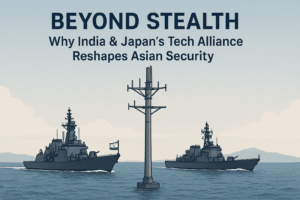Beyond Stealth: Why India & Japan’s Tech Alliance Reshapes Asian Security
India and Japan are forging a transformative defense technology partnership, moving far beyond conventional arms deals. The landmark co-development of advanced UNICORN stealth masts signifies Japan’s unprecedented willingness to share cutting-edge military technology – previously restricted – reflecting deep strategic trust. This collaboration directly counters rising regional tech dominance races by merging Japan’s precision engineering with India’s industrial scale and Indian Ocean presence.
It pioneers joint development of sensitive systems like revolutionary submarine propulsion, aiming for mutual strategic autonomy. Crucially, this democratic tech alliance prioritizes shared values and a stable Indo-Pacific order over mere transactional exchange. The partnership accelerates India’s naval modernization with world-class capabilities while offering Japan a vital strategic partner and market. Ultimately, it represents a fundamental shift from passive cooperation to active co-creation, reshaping Asia’s security landscape for decades.

Beyond Stealth: Why India & Japan’s Tech Alliance Reshapes Asian Security
The headlines capture the breakthrough, but the real story lies deeper: Japan is sharing its crown-jewel defense technology with India in a partnership that fundamentally rewrites Asia’s strategic playbook. This isn’t just an arms deal; it’s the birth of a democratic tech alliance designed for 21st-century challenges.
The Catalyst: The UNICORN Mast
At the heart of this shift is the co-development of the Unified Complex Radio Antenna (UNICORN) mast. This isn’t just another ship component. Its sophisticated design integrates multiple communication systems into a single, streamlined structure, drastically reducing a warship’s radar signature – a critical advantage in modern naval warfare where detection can mean defeat.
Why This Signals a Sea Change:
- Japan’s Historic Shift: For decades, Japan’s strict self-imposed constraints on arms exports and technology sharing, rooted in its pacifist constitution, were near absolute. Sharing cutting-edge stealth technology – technology deployed on its advanced Mogami-class frigates – with India marks a profound policy shift. India becomes only the second Asian nation (after the Philippines, though on a vastly different scale) to receive such high-grade defense tech from Tokyo.
- Strategic Trust, Not Just Trade: This agreement transcends a simple buyer-seller relationship. Japan isn’t just exporting a product; it’s jointly developing sensitive technology with India through Bharat Electronics Limited (BEL). This signifies an unprecedented level of strategic trust, recognizing India as an indispensable partner in maintaining a stable Indo-Pacific.
- Countering the Tech Dominance Race: The Indo-Pacific is witnessing an intense competition for technological superiority, particularly in maritime domains. By pooling Japan’s world-leading precision engineering and advanced materials science with India’s vast market, growing technical prowess, and strategic position in the Indian Ocean, this partnership aims to create a counterweight, ensuring neither democracy is left behind.
Beyond the Mast: The Ripples of a Deeper Partnership
The UNICORN mast is likely just the first wave:
- Submarine Revolution: Japan’s Sōryū-class submarines, featuring revolutionary lithium-ion battery technology, offer unmatched stealth and endurance compared to conventional systems. Collaboration here could leapfrog India’s indigenous submarine capabilities and significantly alter underwater dynamics in the Indian Ocean.
- A Broader Tech Ecosystem: This partnership paves the way for joint development across the spectrum: advanced sensors, unmanned systems, AI integration for command and control, and potentially missile defense. It’s about building complementary industrial ecosystems.
- The Democratic Tech Alliance: Crucially, this is framed as a partnership of democracies with shared values and a shared vision for a “Free and Open Indo-Pacific.” It represents a conscious effort to build security architectures based on transparency, rules, and mutual interest, distinct from other models emerging in the region.
The Strategic Calculus:
- For Japan: It diversifies security partnerships, gains access to India’s strategic geography and market, bolsters its own defense industry through co-development, and actively shapes regional security to counterbalance assertive powers.
- For India: It accelerates its naval modernization with world-class, often previously inaccessible technology, enhances indigenous defense R&D and manufacturing (Atmanirbhar Bharat), and secures a high-tech partner for long-term strategic autonomy in the face of complex regional threats.
The Verdict: Reshaping the Board
The India-Japan tech defense partnership is far more than a single co-development project. It’s a strategic recalibration. By moving beyond traditional constraints and embracing deep technological collaboration, these two major democracies are forging a new pillar of Indo-Pacific security. Their success won’t just be measured in new ships or submarines, but in their ability to foster a stable regional order where technological edge and shared democratic principles define the future. The era of passive defense cooperation is over; the era of active, high-tech co-creation has decisively begun.
You must be logged in to post a comment.